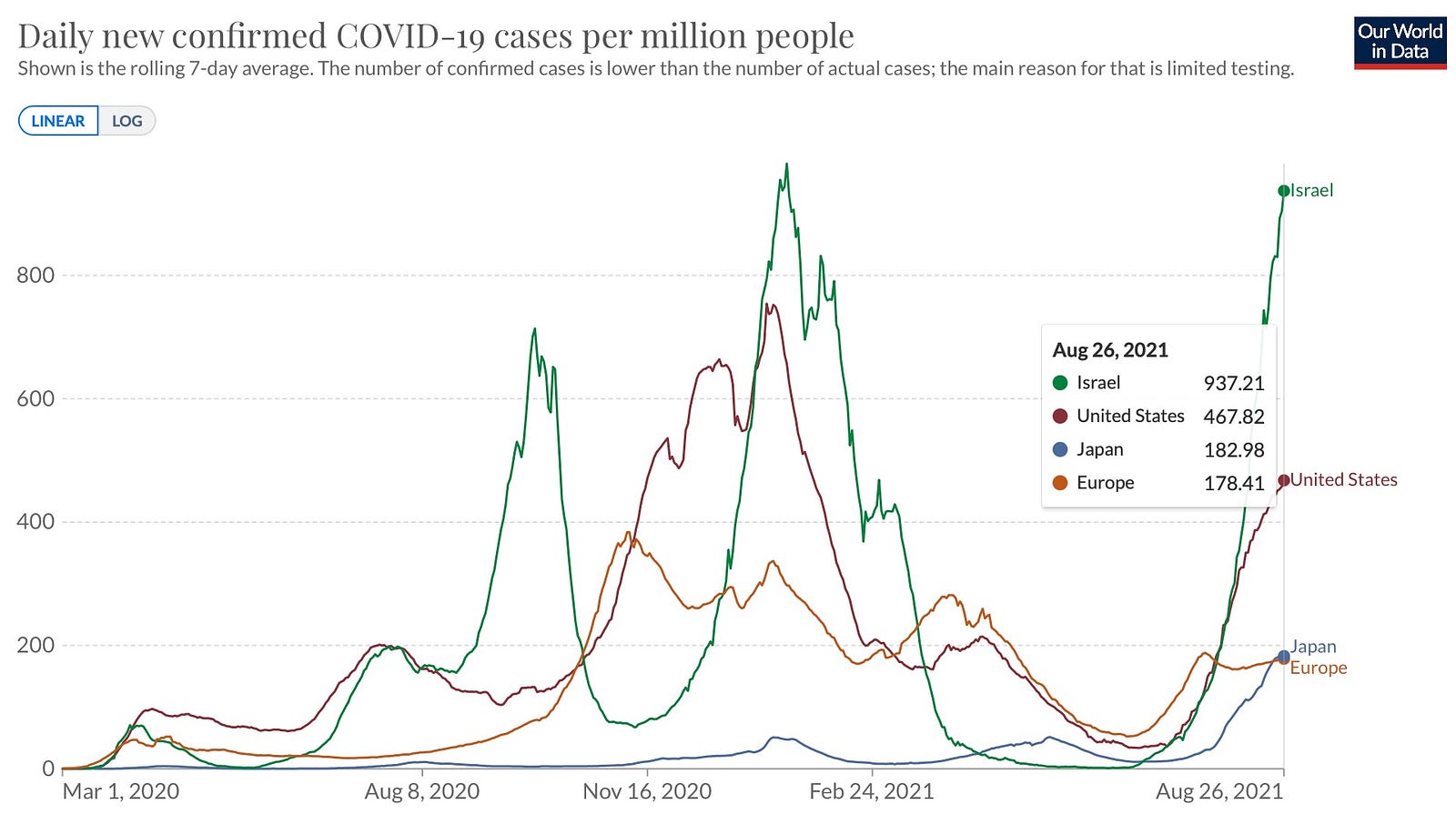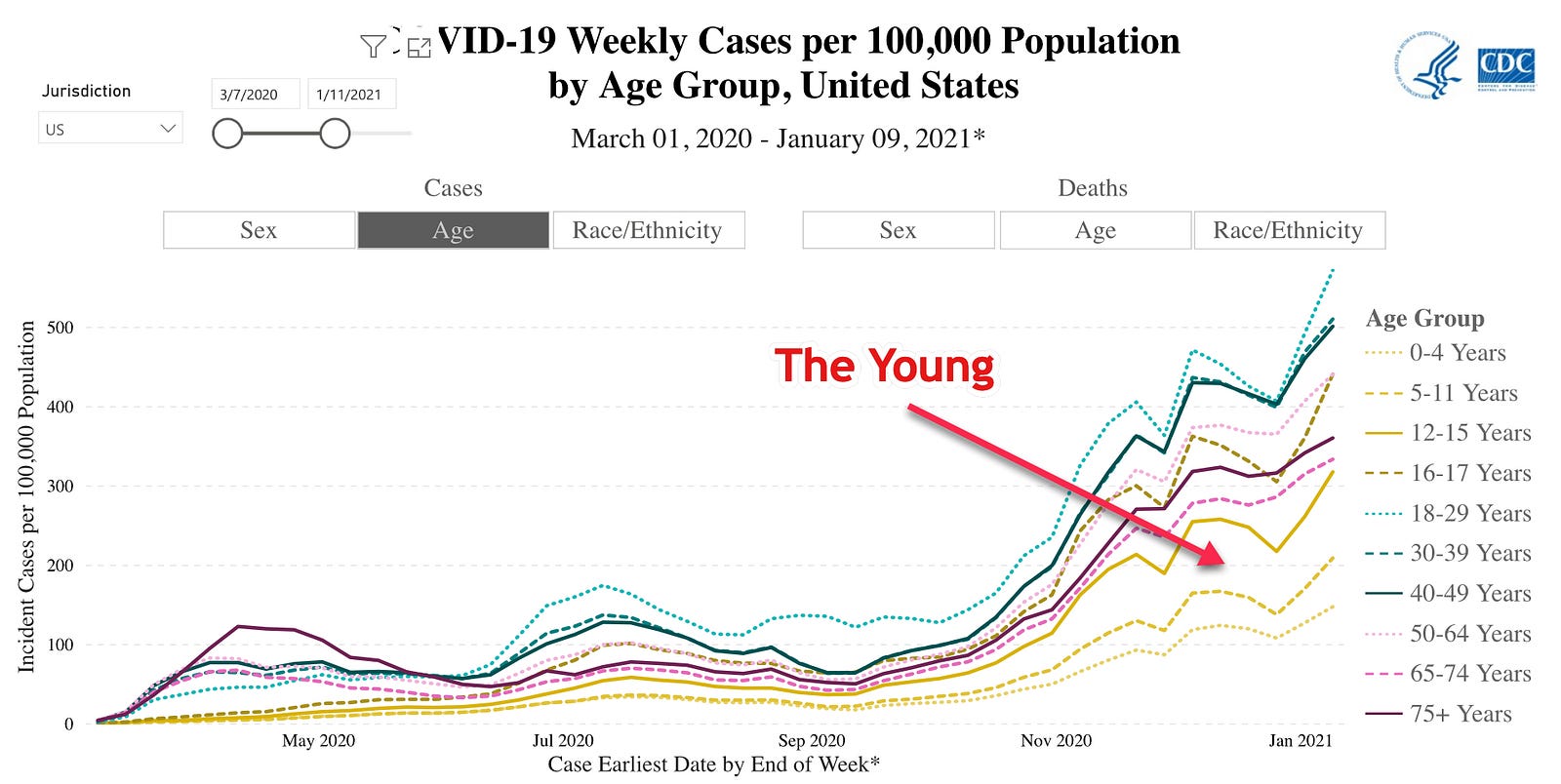Ahhh, Covid-19. It just won’t go away.
As much as I want to yield to my Southern spirit and yell “Enough of these masks and mandates!”… I have to calm myself. Most Americans, most schools, most states, and most federal agencies are sincerely trying to do the best they can to help as many people as possible.
One of the positive lessons of the last eighteen months is pretty simple:
People can be remarkably flexible in protecting what they care about.
We see that flexibility when a restaurant shifts to take-out business, a school figures out how to keep kids in class, a family adjusts to a remote life, or vaccines are developed at a record pace.
The real question now is
“What do people most care about?”
Some care most that Covid-19 is resurgent.
We see infections spiking in Israel, the US, and Japan after thankfully dropping in India.

Many Japanese appear particularly concerned because they had been doing a great job of social distancing, masking, and contact-tracing. Everything except vaccinations. All of a sudden in the last four weeks Japanese infections have marched up to European levels.
Others care most that Covid-19 is impacting the young more than in 2020.
It is true that throughout 2020 children in the 0 to 15 age brackets remained the least impacted groups. At the start of the pandemic, the first US group attacked was the most aged ,75+. By June, the largest number of infections resided in the age groups 18–29, 30–39, and 40–49.

https://covid.cdc.gov/covid-data-tracker/#datatracker-home
In the latest surge, we’ve seen a striking change. Children now appear much more likely to be infected and even harmed. Children from 0 to 15 have shifted from the least-represented to middle-of-the-pack. In recent weeks, 16–17 year-olds have leaped ahead of 40–49 year-olds.

https://covid.cdc.gov/covid-data-tracker/#datatracker-home
What’s going on?
The Delta variant has made an extremely-infectious disease even more so. Some groups are protecting themselves. Others are not.
With 80% of Covid-19 deaths associated with the most at-risk, these groups have taken actions to protect themselves and their loved ones. More than 89% of the most at-risk Americans have received at least one vaccination.
On the other hand, many of the youth who were isolated through much of 2020 are taking less precautions. Those under 15 cannot be vaccinated. Young adults, the middle-aged, and those untrusting of government have the lowest rates of vaccination and, therefore, a greater chance of becoming harmed by this highly-contagious disease.
There are some who care most that Covid-19 seems less deadly than in 2020.
Comparing mid-2021 to mid-2020 in the US, we see a massive drop in the death rate.

In April 2020 the US saw weekly deaths peak above 50 per 100k among the most aged Americans. In the 65–74 group, weekly deaths rose above 10 per 100k and about 5 per 100k among 50–64 year-olds. This compares to a weekly total US death rate in 2019 of about 3.1 for heart disease, 2.8 for cancer, and .9 for accidents.
Covid-19 did not bring apocalyptic numbers, but caring for the Covid surges did overwhelm many local medical systems. Since April of 2021 and during the current surge, weekly death rates have moderated significantly.

https://covid.cdc.gov/covid-data-tracker/#datatracker-home
Among the oldest Americans, the weekly death rate is about one-tenth of its previous high. Among 65–74 year-old’s, we see around 1.5 deaths per 100k and under .5 deaths per 100k for 40–49 year olds.
What’s going on?
The two charts above make death rates seem pretty similar in 2020 and 2021, right? But check the scales. The 2020 Death Rate scale is from 1 to 50 deaths per 100k. The 2021 Death Rate scale is from 1 to 5 deaths per 100k!
The other sneaky part, kinda hidden by these charts, is that death rates among the middle aged may well have ticked up a little. And as the numbers of infected approach the worst 2021 levels, we are seeing regional hospitals again overwhelmed, which will likely push future death rates higher, too.
Fortunately, deaths among the very young, though widely reported, remain rare.
Some insist that Covid-19 is really not deadly at all, about the same as the flu.
This is the biggest concern for many. If the disease doesn’t hurt most folks too much, then why defend against it? Much less shut down an economy!?!

Covid-19 case fatality rates have evolved wildly across the world in 18 months. As of August 2021, across ten countries we see rates from .79% to 2.86% and a world average of 2.08%.
The Covid-19 mortality rates since January 2020 have ranged between the levels associated with smallpox and the annual flu. One of the last smallpox epidemics in the US in 1901 presented a 17% mortality rate. The 2018–19 flu mortality rate was slightly less than .01%.
Critics of mask mandates can argue correctly that, though a 2.08% case fatality world average may be true, it does not represent reality for lower-risk sub-groups and is higher than the true mortality rate. In early August the CDC openly stated that American children less than 5 have a greater chance of major complications from the flu than from Covid. That message, by the way, was recently removed from the CDC website.
What’s going on?
We will not agree upon a Covid true mortality rate for some time. It’s not about politics. Rather it’s about timing.
Likely we will conclude that a few groups in the US face a risk similar to that of the flu (children < 5), that many groups face a risk a few multiples higher than the flu (healthy, white, middle-class women, age 20–25), and that other groups face a threat 5, 10, and 15 times or more worse than the flu.
Supporters of Covid-prevention measures will argue that—no matter the percentages—Covid is a nasty disease that can kill people of any age. Covid creates long-term health issues in many who recover from it, harms the poor and people of color at vastly higher rates, and uses up medical resources far more than the flu — killing people via Covid and also by blocking access to other life-saving medical care. All true.
So, given all the above, what are the realities of Covid-19?
Reality #1: Covid-19 (and its side effects) will be with us for some time
Unlike the SARS-CoV-1 outbreak of 2002, SARS-CoV-2 and Covid-19 has not been contained by human effort or by good fortune. Covid-19 could step back for a season or two, but it and its variants are very likely to periodically reappear across the globe in significant numbers. Like the annual flu “booster” shot, the annual Covid shot will become the norm for many, especially in wealthy countries.
Medical facilities could require masking…forever. Medical facilities have discovered real reductions in airborne disease as a result of masks. Mask wearing may become permanent in some facilities, or required during intense viral seasons, or required for some at-risk people.
New levels of remote work and telemedicine will remain with us…forever.
Reality #2: Covid can become more (or less) infectious
The latest Covid waves in India, Japan, and the US have been fueled by an even more rapidly-spreading Delta version of SARS-CoV-2, the virus behind Covid. Covid-19 can and will change over time.
Reality #3: When well-managed, Covid has become less deadly
The fact that hospital workers have not been devastated en-masse by Covid disease suggests strongly that social distancing measures and masking work.
The Covid-19 vaccines have proven far more effective than our existing annual flu shots. They have already shown to be among the most helpful vaccines in history. The vaccinated are many times less likely to catch Covid or to be hospitalized or to suffer severe complications from the SARS-CoV-2 virus. The Covid-19 vaccinations work.
In 2021, we know how to minimize the spread and how to treat Covid-19 so that the virus does much less harm.
Reality #4: When poorly-managed, Covid-19 is still deadly
Covid-19 remains a deadly disease — far more dangerous than the common flu. It can spread quickly, kill, and cause long-term lung and other impacts. Almost 640,000 Americans are dead from Covid-19 through August 2021. In eighteen months Covid-19 has killed more than twice the number of Americans lost to the flu in the last ten years.
As one more comparison for scale, Covid has killed as many Americans as died in the Civil War, almost as many as have been killed in all US wars since the Civil War.
Reality #5: A top victim of Covid-19 is our medical system and the social fibers that unite us
During the Covid-19 surge of August 2021, regional ICU beds in states ranging from Idaho to Florida find themselves at capacity. Our current medical system was not designed to support such large numbers of acute respiratory disease patients.
From the appearance of Covid-19 in early 2020, most medical authorities have warned about Covid’s impact on the overall medical system — the broader ability to deliver medical care.
Reality #6: Lockdowns and mandates should almost never be deployed
Reality #3 (Well-managed, Covid is becoming less deadly) suggests that lockdowns and mandates should be unnecessary to preserve lives.
Reality #5 (A top victim of Covid-19 is our medical system and the social fibers that unite us) argues that the only time to consider lockdowns or mandates is when hospitals or other social systems are becoming overwhelmed.
Reality #1 (Covid-19 (and its side effects) will be with us for some time) suggests that we need to openly debate how to manage the coming cycles of Covid-19 and the next disease that arrives over the coming decade.
In a better world, it feels like we could
Admit that no one has perfect understanding of new challenges when they arrive.
Admit that we will make mistakes, learn, and change our thinking over time, often quickly.
Agree that mandates are not desirable in a free society of free people.
Agree that people should actively take measures to care for their families and communities.




